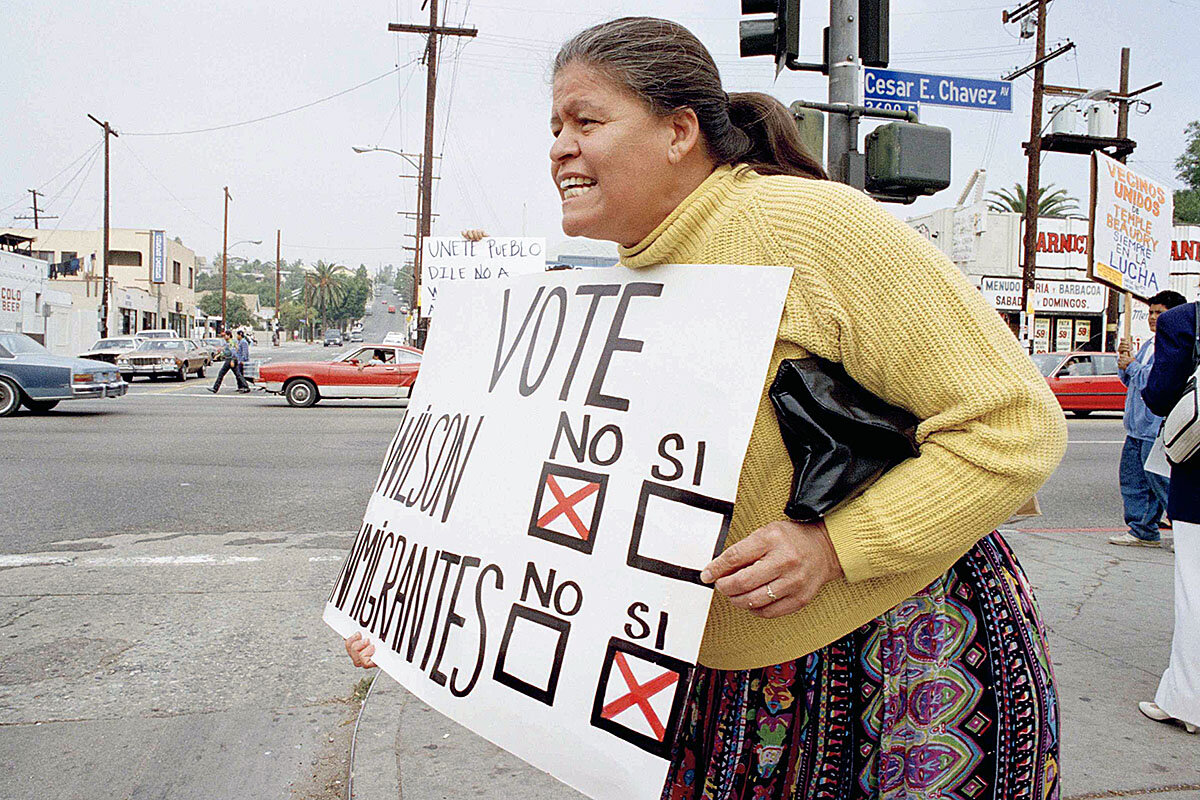As Latinos’ political clout grows, could U.S. follow path of California?
Loading...
| Pasadena, Calif.
The number of Latino voters nationwide nearly doubled from 2014 to 2018, and Latinos turned out in droves in both 2018 and 2019’s off-year elections. And while Latinos are not monolithic in their political preferences – in states like Texas and Florida, larger percentages back Republicans than in states like California and New York – a majority of Latinos vote Democratic.
Some experts see a national shift taking place that mirrors what began happening in California more than two decades ago. The 1994 passage of Proposition 187, a ballot measure denying social services to unauthorized immigrants, galvanized California’s Latinos. Political and civic leaders began mobilizing voters and systematically running for office at the state and local level, helping to turn the state a deep blue.
President Donald Trump’s election in 2016 “did something similar,” says Matt Barreto, co-founder of Latino Decisions. “It was through winning and governing on an anti-immigrant strategy that [Mr. Trump] has started to get a reaction. He’s worked people up.” The question, he adds, is whether the motivation will continue for the next 12 months.
Why We Wrote This
Watershed events can spark long-term political change. Will President Donald Trump’s immigration stance prove to be the kind of catalyst for Latinos nationwide that the passage of Proposition 187 was in California in the 1990s?
When Mayra Macías looks at the recent off-year elections in Arizona, she sees shades of California. For the first time, voters in Tucson put a Latina – Regina Romero – in the mayor’s office. The last time voters there elected a Latino mayor was in 1875.
The election of Ms. Romero, a Democrat who served three terms on the city council, “is a harbinger of what’s possible when you engage communities of color,” says Ms. Macías, executive director of Latino Victory, a progressive organization that recruits and supports Latino candidates across the country.
To her, that means more Latinos in office, from federal to local government, as well as more Latino voters at polling places – potentially flipping states like Arizona and even Texas from red to blue.
Why We Wrote This
Watershed events can spark long-term political change. Will President Donald Trump’s immigration stance prove to be the kind of catalyst for Latinos nationwide that the passage of Proposition 187 was in California in the 1990s?
And she sees clear parallels to a shift that took place in California more than two decades ago. In November 1994, a watershed moment galvanized the state’s Latinos, motivating them to organize and pushing them overwhelmingly into the Democratic camp. That moment was the passage of Proposition 187, a ballot measure that sought to deny social services such as education and health care to unauthorized immigrants. It was backed by Republican Gov. Pete Wilson, who rode it to reelection.
The measure was found unconstitutional, but it – along with other targeted measures in the state – alarmed and angered many Latinos. Their political and civic leaders began systematically running for office at the state and local level, and mobilizing voters. Now the largest ethnic group in the state, Latinos played a huge role in turning California deep blue and steering its policy.
Similarly, says Ms. Macías, the Trump presidency is proving to be a watershed moment for Latinos on a national scale. “President Trump launched his campaign denigrating [immigrants] and spewing the same rhetoric as for Proposition 187,” she says. “Latinos are paying attention.”
Ms. Macías and others on the front lines of organizing say the road to the White House runs through their community. But over the years, turnout has been a consistent challenge. In California, Latino turnout spiked after Proposition 187, then fell back again.
Still, Latinos came out in droves in the 2018 midterm elections, as well as in this year’s off-year elections, says Matt Barreto, co-founder of Latino Decisions, which specializes in public opinion research. It is a direct reaction to President Donald Trump, he says.
According to Pew Research Center, the number of Latino voters nearly doubled from 2014 to 2018. And Mr. Barreto notes “extremely high voter turnout” in Latino precincts in Virginia earlier this month, calling it “consequential” in flipping the statehouse to Democratic control. With a Democratic governor, Virginia is now completely blue for the first time in 26 years.
Just as then-Governor Wilson’s reelection in California in 1994 set off a wave of voter engagement, President Trump’s election in 2016 “did something similar,” says Mr. Barreto. “Trump still won, much like Pete Wilson did. But it was through winning, and governing on an anti-immigrant strategy, that [Trump] has started to get a reaction. He’s worked people up.”
The question, says Mr. Barreto, is whether the motivation will continue for the next 12 months.
Mr. Barreto notes the considerable growth in Latino political organizing, with groups such as Latino Victory, Mi Familia Vota, Voto Latino, and the Dreamer youth activists making their voices heard. “No longer do you just have LULAC and La Raza [now UnidosUS],” two core groups that go back decades.
“Formal organizing is so much stronger,” he says. For instance, Latino Victory went from endorsing 15 Latino candidates in 2016, to 58 in 2018 – at all levels, from governor to city council. It is being inundated with requests from potential candidates.
And Mr. Barreto points to something else: self-mobilizing. “We picked this up in our polling in 2018,” he says. “A record number of voters were telling us they were doing micro-mobilizing among friends and family. People are realizing how high the stakes are.”
He also credits Latino leaders such as Democratic Rep. Ben Ray Luján of New Mexico, who last year headed up the Democratic campaign arm in the U.S. House as it ushered in a Democratic majority in a blue wave. “They had a whole lot of folks involved who knew they had to do that outreach.”
Case in point: Texas. In last year’s midterms, 800,000 more Latinos voted than in 2014, according to Democratic National Committee Chairman Tom Perez at a recent Monitor Breakfast. But more than 3 million Latinos who were eligible to vote stayed home. Given that former Democratic Rep. Beto O’Rourke of Texas lost his challenge to incumbent GOP Sen. Ted Cruz by just over 200,000 votes, the opportunity for Democratic victories in 2020 seem tantalizingly close.
“Texas is a remarkable potential opportunity,” said Mr. Perez, the DNC’s first Latino chair, citing at least six pickup possibilities for Democrats in the U.S. House, as well as the possibility of flipping the Texas House of Representatives.
Still, Latinos are not monolithic in their political preferences. A new study by the University of Houston points out that in some states – like Texas and Florida – larger percentages of Hispanics back Republicans than in states like California and New York, though a majority still votes Democratic.
“Is it fair to say that an Anglo in Texas votes the same as an Anglo in New York? No. They have different upbringings, different backgrounds,” says Ivan Andarza, a board member of the Hispanic Republicans of Texas. The story of California’s Latinos will not be repeated in the Lone Star State for the simple reason that “they’re much more conservative in Texas.”
Mr. Andarza, an immigration attorney in Austin, admits that President Trump’s immigration rhetoric “does have an effect on Hispanics.” He also says the surge in Latino voting in 2018 means “we gotta work harder on the Republican side.”
However, he calls 2018 a “special circumstance” in Texas. Mr. O’Rourke ran as a moderate against a weakened Senator Cruz, but tacked much further to the left as a presidential candidate in 2019. Conservative voters won’t be fooled next time, he predicts – citing the strong showing of the state’s Republican Gov. Greg Abbott, who won a second term with 42% of the Hispanic vote last year.
Mr. Andarza praises Governor Abbott and previous Republican governors in the state for their extensive outreach to Hispanic voters. Democrats have taken Hispanics for granted in the past, he says, though that’s changing.
Indeed, candidates can’t count on opposition to President Trump alone to energize Latino voters. “I think it’s a mistake to only use Trump as a rallying cry,” says Mindy Romero, director of the California Civic Engagement Project, which is based in Sacramento and affiliated with the University of Southern California. “The messages we know that work are messages that connect back to your community, your family, the issues.”
Ms. Macías agrees.
“We need to give the Latino community entry points, and ask them to engage,” she says, with campaigns and candidates reaching out early and often. “It is not enough for folks to be angry.”









